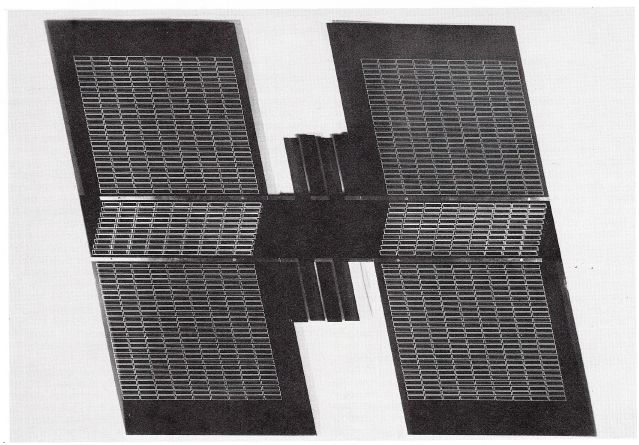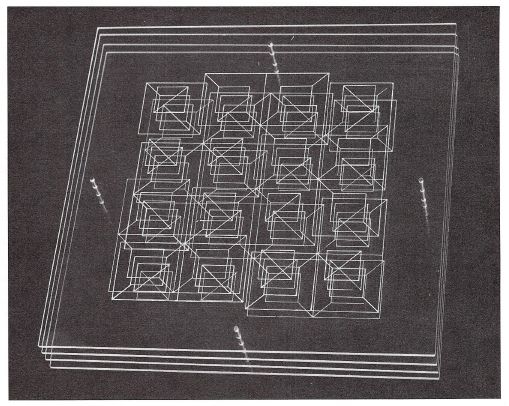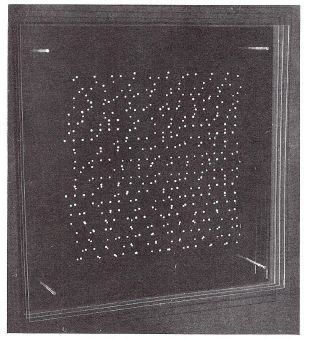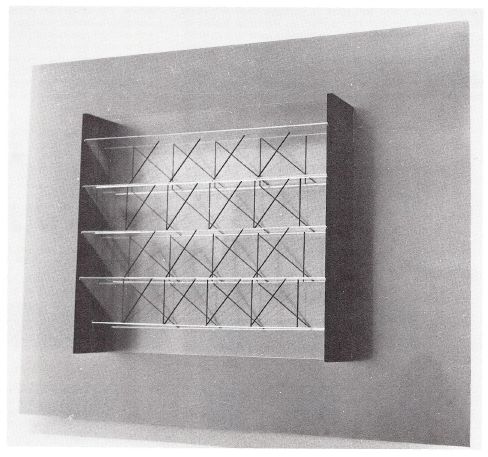TONY LONGSON
SIGHT AS A MOTIVATION
Sight is what interests me—in particular the richness of being able to see space—and this is what makes me make things.
The constructions I make are like drawings in space. They are made up of simple elements, such as lines and dots on clear sheets of material, which direct the way we see, and perhaps show us new things about the way we can see. Within these main aims there are other areas that interest me; the ambiguity of things that are flat yet appear to be three dimensional, and far more exciting, things which we know are in space which appear to be flat. I also like the distinction between pattern and not pattern; for example, recently I've been trying to spread small dots within a square in order to achieve a kind of 'grainy' surface. It's very difficult, I tried several random processes, but eventually had to determine precisely the pattern of individual dots so that no strong pattern groups were apparent.
This interest in sight as a motivation stems from the time I studied Fine Art at Reading University. Terry Pope introduced me to his 'extended parallax' glasses which, by increasing the distance between our eyes, dramatically heightens our impression of the space surrounding the objects we are looking at. I went on to build glasses which reduce the distance between our eyes, and was equally impressed with the new reading of space that they offered. It occurred to me then that there were many different possible configurations of two eyes which might provide exciting visual results. However, it was not until I came across computer generated stereo pairs that I realized I had a relatively simple way of checking all the alternatives.


So having turned to computers with that specific problem I began to see many ways in which they could extend my work. First of all I was interested in getting the computer to draw three dimensional objects. I set out to design objects which could be rotated into certain positions where they would appear to be flat. It was an interesting exercise as it made me aware of the many conventions we adopt, such as perspective, overlapping, and shading to depict space on a flat surface. Of course my first drawings were simple isometric projections. I went on to do exactly the reverse—that is to make three dimensional objects which appear to be flat from certain viewpoints. There was something attractive about seeing this unfamiliar situation.
Initially I thought it was enough to have someone else do the programming. Now I use computers in many aspects of my work (supported for two years by the Arts Council and Hatfield Polytechnic) and I find that I need to have control over every stage of the process. This means programming in FORTRAN, BASIC, and POP2 (more of that later), and being able to manipulate the various machines. Hatfield's main computer is a PDP-10, but there is also a small computer with a refresh display system and light pen which is connected to the 10. The majority of my work starts on this visual display, though not as an end in itself, rather as experiment towards making drawings in three dimensions. My latest sequence of work has been to investigate certain of the thresholds in the way we see. I enjoy visual information that will waver between two states, but never be both at the same time. I wanted to explore information that was highly structured, and yet at times seemed to be haphazard. I chose very small white dots as the elements to be seen against a black background. The geometry was to make a perfect matrix of dots within a twenty by twenty square, though as the dots could be on any one of the four separate layers which made up the drawing, that geometry would only be visible from face on. (Because of the diminishing effect of perspective, I made the dots and the matrix slightly larger as a function of their increased distance.) Added to this structure, I made the arrangement of dots symmetric about both horizontal and vertical axes (would that be obvious in the piece of work?). The square matrix was the only structuring that I wanted to be apparent in the work. From every other viewpoint the dots themselves had to have this grainy quality, that is, to have no local groupings which would be recognizable as strong patterns. This, of course, is the most simple explanation of something that has to be seen. The visual response that an object like this solicits is something that cannot easily be described. In the end, the whole is more than the sum of the parts.
To make the work, I've been using a numerically controlled three axis milling machine, which accepts information as co-ordinates on paper tape, and cuts corresponding lines or dots into the component sheets of clear perspex. It provides the necessary accuracy. Ironically mistakes are far easier to detect in visual information that is highly structured.
Well, there are significant problems in using a computer to creative ends; one obvious one is that the common output devices produce images with that characteristically dull quality about them. Also I find that each construction demands a totally new approach, and that rather goes against one of the fundamentals of a computer, the ability to repeat the same task reliably many times over; but what I see as their greatest limitation to creativity is possibly also the very area of greatest potential. The limitation is this—a computer needs to have the problem closely described, and there are ingredients of creativity which cannot be described.

The potential, then, is to simulate the creative process itself. How can I do that? First I have to isolate those aspects of creativity which I do know about; simply recording them from my own methods. The computer has to have this information and non-numeric languages are available for expressing it (POP2 is one of them). Heuristics is a tested method for 'best bet' decision making where there are too many choices to investigate. And there is the kind of associative memory system which reinforces itself over a period of 'experience' of right and wrong choices. Hopefully this memory is common to an extended sequence of investigation. Given this situation, perhaps we can discover some of the mystery of creative thinking. I anticipate one serious problem. If the computer does make that kind of intuitive leap that we associate with being creative, how will I recognize it for what it is?
At least I am learning more about my own working methods—at best the computer may assist decision making in a naturally creative way.
Hatfield, Herts, England
September 1975

Return to Table of Contents | Previous Section | Next Section

